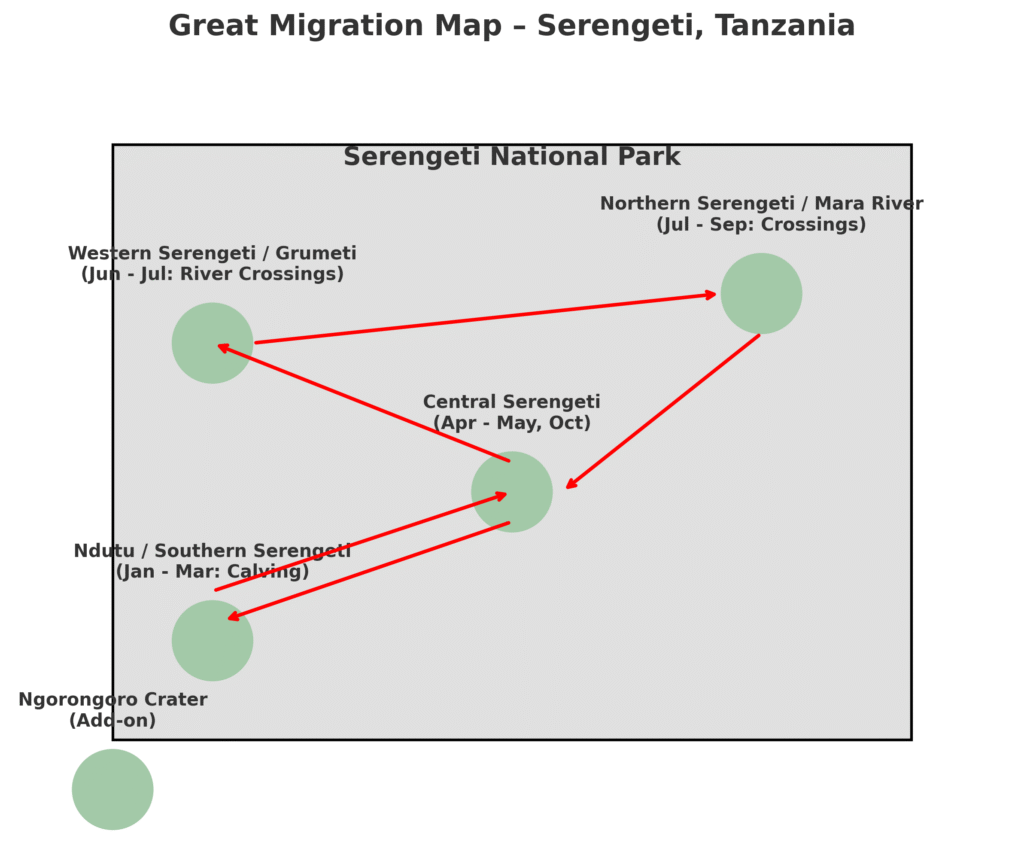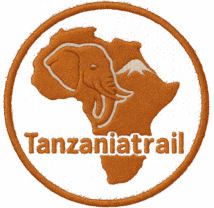Best Time to See the Great Migration in Tanzania
The Great Migration in Tanzania is the largest land-based wildlife migration on Earth and one of the planet’s most awe-inspiring natural events. Each year, more than 1.5 million wildebeest, along with hundreds of thousands of zebras and gazelles, follow an ancient path across the Serengeti ecosystem in search of fresh pastures and water. This epic journey is not a single event, but a continuous cycle that spans the entire year — making Tanzania the only country where you can see the migration in action every month.
Best Time to See the Great Migration in Tanzania
Overview – The World’s Greatest Wildlife Show
The Great Migration in Tanzania is the largest land-based wildlife migration on Earth and one of the planet’s most awe-inspiring natural events. Each year, more than 1.5 million wildebeest, along with hundreds of thousands of zebras and gazelles, follow an ancient path across the Serengeti ecosystem in search of fresh pastures and water. This epic journey is not a single event, but a continuous cycle that spans the entire year — making Tanzania the only country where you can see the migration in action every month.
What makes this migration so remarkable is its sheer scale and drama. Whether it’s the miracle of calving season, the thundering of hooves across endless plains, or the chaos of river crossings where crocodiles and predators await, every chapter of the migration tells a story of life, death, and survival. For safari-goers, timing your visit means choosing the version of the story you want to witness: the tenderness of new life, the spectacle of predator hunts, or the adrenaline of river crossings.
Unlike other safari highlights, the Great Migration is dynamic — it moves with the rains, grass, and seasons. This means there is no single “best time”, but instead different best times depending on your preference. Do you want to photograph newborn calves in the green season? Witness dramatic river crossings in the north? Or enjoy quieter, crowd-free safaris in the shoulder months? The good news is, with the right itinerary, you’ll always find the herds.
With Tanzaniatrail, we position you in the right place at the right time. Our expert guides track the migration’s movements daily, and our carefully chosen mobile camps and lodges put you right in the heart of the action. Whether you’re a first-time traveler or a seasoned safari enthusiast, we make sure you don’t just see the migration — you live it.
Month-by-Month Guide to the Great Migration
January – March: Calving Season (Ndutu & Southern Serengeti)
This is the most emotional and photogenic chapter of the migration. Between January and March, the short-grass plains of Ndutu and the southern Serengeti become nurseries, as wildebeest give birth to nearly 500,000 calves in just a few weeks. With up to 8,000 newborns arriving daily in February, predators such as lions, cheetahs, and hyenas patrol the plains, leading to dramatic hunts. The green season provides lush backdrops, fewer tourists, and fantastic opportunities for close encounters, especially since off-road driving is permitted in Ndutu.
April – May: Green Season Movement (Southern to Central Serengeti)
The long rains begin, transforming the Serengeti into a sea of green. Herds start to disperse, moving from Ndutu toward the central Serengeti. While predator-prey drama is less intense, this period is peaceful and uncrowded — perfect for travelers who want exclusivity. Photographers love the dramatic skies, vibrant birdlife, and wildflowers. Lodges often offer reduced rates, making it more affordable.
June – July: Grumeti River Crossings (Western Serengeti)
By June, the herds gather in the western Serengeti near the Grumeti River, where giant Nile crocodiles lie in wait. This is the first river challenge for the wildebeest, less famous than the Mara crossings but equally thrilling. Expect nail-biting moments as herds leap into the water. Beyond the river, the Western Corridor offers open plains, excellent predator action, and fewer crowds than the north.
July – September: Mara River Crossings (Northern Serengeti)
This is the most iconic and dramatic stage of the migration. Herds gather along the Mara River, on the border of Tanzania and Kenya. Watching wildebeest hesitate, then suddenly surge into crocodile-infested waters, is one of the rawest wildlife spectacles in the world. Predators wait on both sides, and survival is uncertain. This season draws travelers from around the globe, so booking early is essential.
October: Herds in the North, Moving South
In October, herds linger in the northern Serengeti but begin preparing for the return south. The atmosphere is calmer, with fewer crossings, but it’s still an excellent time to see large herds and predators. The weather is dry, and visibility is superb for photography.
November – December: Return to Southern Serengeti
The short rains pull the herds back toward the south. By December, wildebeest are concentrated in the Ndutu and southern Serengeti again, feeding on fresh grasses to prepare for calving. This is the start of the migration’s next cycle, and it’s a beautiful time with vibrant green scenery and fewer visitors.
Best Parks to See the Migration
Ndutu & Southern Serengeti
Best for calving season (Jan–Mar). Witness thousands of births, predator hunts, and intimate off-road experiences. Perfect for photographers and families seeking dramatic yet tender wildlife moments.
Central Serengeti (Seronera Valley)
A year-round wildlife hotspot. Even when the migration is elsewhere, Seronera offers lions, leopards, cheetahs, elephants, and hippos. It’s a great base for April–June and October–December when herds pass through.
Western Serengeti (Grumeti Region)
Best for June–July. The Grumeti River crossings are dramatic but less crowded than Mara. This region also has rich landscapes and plenty of predators.
Northern Serengeti (Kogatende, Lamai)
Best for July–September. Home to the Mara River crossings, this is the migration’s most dramatic stage. Camps in Kogatende and Lamai offer front-row access to the riverbanks.
Ngorongoro Conservation Area
While not part of the main migration path, it’s a perfect add-on to see the Big Five and the rare black rhino. Often included in itineraries for variety.
Practical Tips
-
Book early for July–September, as northern Serengeti lodges fill fast.
-
Choose mobile camps that move with the herds for maximum immersion.
-
Carry binoculars and long-lens cameras to capture distant crossings.
-
Pack layers for cool mornings and warm afternoons.
-
Add Zanzibar at the end for a relaxing beach escape.
Frequently Asked Questions (FAQ)
Q1: Can I see the migration year-round?
Yes, the migration is always moving. Tanzania offers sightings every month.
Q2: When is the best time for calving?
January–March in Ndutu, with February as the peak.
Q3: When is the best time for river crossings?
June–July (Grumeti) and July–September (Mara).
Q4: Can I see all stages in one trip?
No, but with a 2–3 week itinerary you can combine different areas.
Q5: Which area is best for fewer tourists?
April–May (green season) and October are peaceful.
Q6: Is it guaranteed to see a river crossing?
No, they are unpredictable. Staying several days increases chances.
Q7: Are mobile camps safe?
Yes, they are comfortable and secure, positioned close to the herds.
Q8: How far in advance should I book?
For July–September, at least 9–12 months ahead.
Q9: What’s the best safari length for migration?
6–8 days minimum, 10 days ideal.
Q10: Is it suitable for children?
Yes, many lodges are family-friendly and guides adapt activities.
Q11: What’s the weather like?
Dry June–Oct, green and rainy Nov–May, but always rewarding.
Q12: Why book with Tanzaniatrail?
We combine prime locations, expert guides, custom itineraries, and authentic experiences.
Conclusion – Time Your Journey, Live the Magic
The Great Migration in Tanzania is not one moment, but a year-long cycle of survival, abundance, and drama. From the miracle of calving to the adrenaline of river crossings, every season offers something extraordinary.
By understanding the month-by-month movement, choosing the right parks, and traveling with an experienced operator like Tanzaniatrail Experience Limited, you can plan a safari that matches your dreams — whether it’s newborn calves, predator hunts, or the thunder of hooves at a riverbank.
👉 Ready to see the migration at its best? Contact us today, and let us create your tailor-made migration safari — with the perfect timing, expert guides, and unforgettable experiences.

Giving Back Through Every Journey
At Tanzaniatrail, we believe that travel should create lasting memories and make a positive difference. That’s why 1% of every safari package you book goes directly back to local communities in Tanzania. We regularly visit and support orphanages and community centers, and our dream is to establish a dedicated children’s home under Tanzaniatrail’s care. When you travel with us, you’re not only exploring Tanzania’s beauty — you’re also helping provide education, food, and brighter futures for vulnerable children. Your adventure changes lives. Travel with purpose.
